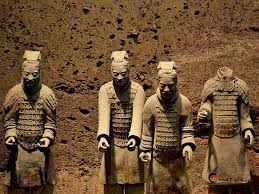
How Many Terracotta Warriors Are in Pit 3?
Pit 3 is the smallest of the three pits housing the Terracotta Army, yet it holds immense historical and archaeological significance. Located near Xi'an, China, this site reveals fascinating details about ancient Chinese military tactics and craftsmanship. One of the most frequent questions about this pit concerns the number of terracotta warriors it houses.
The Number of Terracotta Warriors in Pit 3
A total of 68 lifelike terracotta warriors were excavated from this pit. These warriors were not found scattered randomly but rather arranged in specific formations within the pit, hinting at their intended roles in Qin Shi Huang's afterlife army.
- Southern Wing Room: This section of Pit 3 yielded 42 terracotta warriors.
- Northern Wing Room: The northern wing room contained 22 terracotta warriors.
The Missing Heads of the Terracotta Warriors
A sad reality encountered by archaeologists was the state of many warriors found within Pit 3. A significant number of them were unearthed missing their heads. This damage is believed to be a result of the pit's collapse in antiquity, the weight of the collapsing ceiling crushing the fragile terracotta figures below.
More Than Just Warriors: Other Discoveries in Pit 3
While the terracotta warriors are the undeniable stars of Pit 3, they weren't the only treasures unearthed. This pit proved to be a treasure trove of artifacts offering invaluable insights into the Qin dynasty:
- Bronze Weaponry: Archaeologists uncovered a vast array of well-preserved bronze weapons, showcasing the advanced craftsmanship of the era. Swords, spears, and other arms provided tangible evidence of the military might of the Qin army.
- Precious Decorations: Adding to the opulence, the pit also held a collection of gold, stone, and bronze decorations. These intricate pieces likely adorned the warriors and their chariots, signifying the high status and importance attributed to this subterranean army.
FAQs
Q1: What is the significance of Pit 3's smaller size compared to Pits 1 and 2?
A1: It's believed that Pit 3, with its unique layout and the presence of high-ranking officers, served as the command post for the entire terracotta army. Its smaller size reflects its function as a strategic center rather than a brute force division.
Q2: What can we learn from the arrangement of the warriors in Pit 3?
A2: The organized formations of the warriors, with distinct units and potential command structures, provide valuable insights into ancient Chinese military tactics and strategies.
Q3: What happened to the colors of the terracotta warriors?
A3: Originally, the warriors were vibrantly painted, but exposure to air upon excavation caused the pigments to fade rapidly. Today, only traces of the original colors remain, though ongoing research and conservation efforts strive to preserve and restore what is left of this ancient artistry.